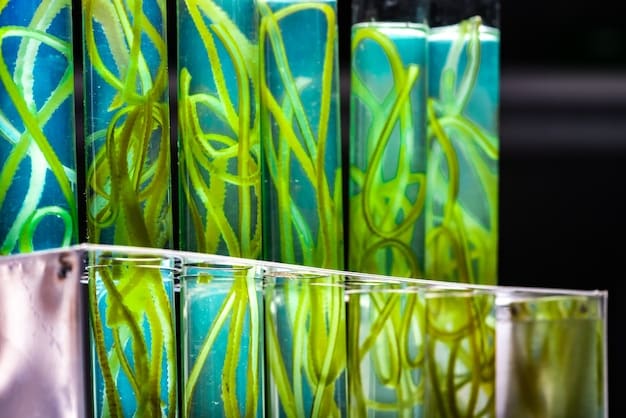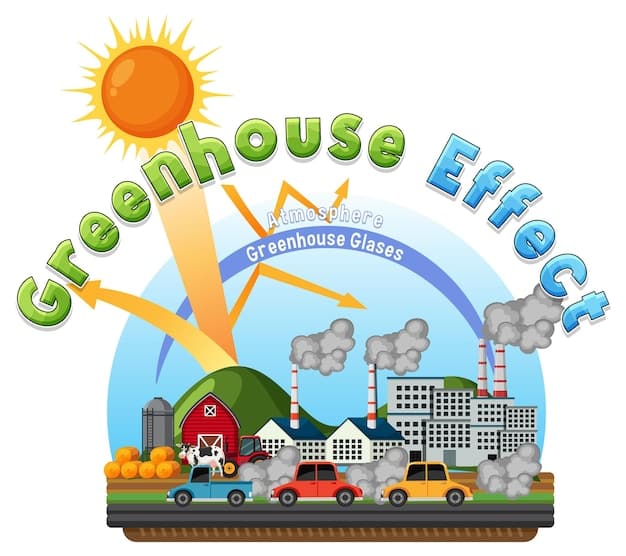Sustainable Aviation Fuel (SAF): US Airlines’ Carbon Footprint Reduction

Sustainable Aviation Fuel (SAF) is playing a crucial role in significantly reducing the carbon footprint of US airlines, with new technologies contributing to an impressive 28% reduction in emissions.
US airlines are increasingly turning to Sustainable Aviation Fuel (SAF): How US Airlines Are Reducing Their Carbon Footprint by 28% with New Technologies to meet sustainability goals and mitigate the environmental impact of air travel, a move fueled by innovation and regulatory pressures. This transition marks a significant step toward a greener aviation industry.
What is Sustainable Aviation Fuel (SAF)?
Sustainable Aviation Fuel (SAF) is a type of jet fuel produced from renewable and sustainable sources, designed as a lower-carbon alternative to traditional fossil-based aviation fuel. Its goal is to minimize the environmental impact of air travel, helping to reduce greenhouse gas emissions significantly.
The key benefit of SAF is its potential to dramatically decrease the carbon footprint of aviation. By utilizing sustainable feedstocks and advanced conversion processes, SAF can achieve substantial reductions in CO2 emissions compared to conventional jet fuel.
Feedstocks for SAF Production
SAF can be produced from a variety of sustainable feedstocks. These range from agricultural residues to waste materials, ensuring the fuel is both renewable and environmentally responsible.
- Algae: Algae can be cultivated in ponds or photobioreactors, utilizing CO2 and sunlight to produce oils suitable for SAF production.
- Non-food crops: Plants like camelina and jatropha can be grown without competing with food crops, providing a dedicated source of sustainable oil.
- Agricultural Residues: Corn stover, wheat straw, and other agricultural byproducts can be converted into SAF through various thermochemical and biochemical processes.

Production Processes
The production of SAF involves several different processes, each designed to convert the feedstocks into usable jet fuel. These methods are continually being refined to increase efficiency and reduce costs.
- Hydrotreating: This process involves reacting the feedstocks with hydrogen under high pressure and temperature, converting the oils into hydrocarbons suitable for jet fuel.
- Gasification: Feedstocks are heated in a low-oxygen environment to produce syngas, which is then converted into SAF via the Fischer-Tropsch process.
- Alcohol-to-Jet (ATJ): Alcohols like ethanol or butanol, produced from biomass, are catalytically converted into jet fuel.
In summary, Sustainable Aviation Fuel represents a sustainable and renewable alternative to conventional jet fuel, leveraging diverse feedstocks and innovative production processes to substantially reduce the carbon footprint of air travel.
The Environmental Impact of Aviation
Aviation’s environmental impact is significant, primarily due to the greenhouse gas emissions produced by burning fossil-based jet fuel. These emissions contribute to climate change and global warming, necessitating a move towards sustainable alternatives like SAF.
Besides carbon dioxide, aviation also emits other pollutants that affect air quality and contribute to environmental problems. These include nitrogen oxides (NOx), particulate matter, and contrails, all of which have adverse effects on the atmosphere.
Greenhouse Gas Emissions
The primary environmental concern in aviation is the release of greenhouse gases, particularly carbon dioxide (CO2). These emissions trap heat in the atmosphere, leading to global warming and climate change.

- Contribution to Global Warming: Aviation accounts for around 2-3% of global CO2 emissions.
- Increasing Air Travel: As air travel increases, so too does the industry’s contribution to greenhouse gas emissions.
- Long-Term Effects: The CO2 emitted by aircraft can remain in the atmosphere for hundreds of years, exacerbating climate change.
Non-CO2 Effects
In addition to CO2 emissions, aviation produces other substances that impact the environment. These non-CO2 effects, such as NOx emissions and contrails, also contribute to climate change.
- Nitrogen Oxides (NOx): NOx emissions can lead to the formation of ozone and contribute to smog and acid rain.
- Particulate Matter: These tiny particles can affect air quality and have adverse health effects.
- Contrails: These condensation trails formed by aircraft can trap heat in the atmosphere, contributing to warming.
In conclusion, addressing the environmental impact of aviation requires a multi-faceted approach, with Sustainable Aviation Fuel playing a crucial role in reducing both CO2 and non-CO2 emissions, paving the way for a more sustainable future for air travel.
US Airlines Embrace Sustainable Aviation Fuel
US airlines are increasingly adopting Sustainable Aviation Fuel as a key strategy to minimize their carbon footprint. This proactive approach demonstrates their commitment to environmental stewardship and sustainable practices.
Several major US airlines have made substantial investments in SAF, signifying their confidence in its potential and their dedication to achieving ambitious sustainability goals. These investments are driving innovation, scalability, and wider adoption of SAF across the industry.
United Airlines
United Airlines has been a frontrunner in the adoption of SAF. Their initiatives include significant investments in SAF production facilities and strategic partnerships to secure a reliable supply of sustainable fuel.
- Investment in Fulcrum BioEnergy: United has invested in Fulcrum, a company that converts municipal solid waste into SAF.
- SAF Purchasing Agreements: The airline has signed agreements to purchase large volumes of SAF over the coming years.
- Eco-Skies Alliance: United launched this program to engage corporate customers in reducing aviation carbon emissions through SAF purchases.
Delta Air Lines
Delta Air Lines has also made significant strides in embracing SAF. Their focus includes supporting the development of SAF technologies and collaborating with industry partners to enhance SAF availability and accessibility.
- Commitment to Carbon Neutrality: Delta has pledged to become carbon neutral and views SAF as a vital component of achieving this goal.
- Partnership with Gevo: Delta has partnered with Gevo, a renewable fuels producer, to secure a long-term supply of SAF.
- SAF Blending: Delta has begun blending SAF into their fuel supply at various airports to reduce emissions.
US airlines are demonstrating a strong commitment to Sustainable Aviation Fuel, driving significant advancements in the industry. Through strategic investments and innovative partnerships, they are paving the way for a more sustainable and environmentally responsible future for air travel.
New Technologies Driving Carbon Footprint Reduction
Innovative technologies are crucial in driving the reduction of carbon footprints in the aviation industry. These advancements span from the production of Sustainable Aviation Fuel to improvements in aircraft design and operational efficiencies, creating a holistic approach to sustainability.
Next-generation aircraft designs are increasingly incorporating fuel-efficient technologies, reducing the amount of fuel needed per flight. Aerodynamic improvements, lightweight materials, and advanced engine designs all play a significant role in minimizing environmental impact.
Advanced Engine Technologies
Next-generation engines are designed to be more fuel-efficient and produce fewer emissions, thereby reducing the carbon footprint of air travel.
- CFM LEAP Engine: This engine offers significant fuel savings and reduced CO2 emissions compared to previous generations.
- Pratt & Whitney’s Geared Turbofan: This innovative engine design enhances fuel efficiency and reduces noise levels.
- Open Rotor Engines: These engines are designed to provide even greater fuel efficiency, though they are still in the developmental stages.
Aerodynamic Improvements
Aerodynamic improvements to aircraft designs can lead to significant fuel savings and reduced emissions. Streamlining the shape of the aircraft and reducing drag are key strategies.
- Winglets: These vertical extensions at the wingtips reduce drag and improve fuel efficiency.
- Laminar Flow Control: This technology aims to reduce drag by maintaining a smooth flow of air over the wings.
- Lightweight Materials: The use of carbon fiber and other lightweight materials helps to reduce the overall weight of the aircraft, improving fuel efficiency.
New technologies are significantly contributing to carbon footprint reduction in the aviation sector. These advancements, coupled with the adoption of Sustainable Aviation Fuel, are essential for creating a more environmentally friendly and sustainable aviation industry.
Government Policies and Incentives
Government policies and incentives play a critical role in encouraging the adoption of Sustainable Aviation Fuel and fostering a more sustainable aviation industry. These policies provide financial support, regulatory frameworks, and research funding to accelerate the transition.
Incentives such as tax credits and subsidies can make SAF more economically competitive with traditional jet fuel. These financial incentives encourage airlines and fuel producers to invest in SAF, driving down costs and increasing availability.
Tax Credits and Subsidies
Tax credits and subsidies are vital incentives for promoting the production and use of SAF. These financial benefits help to offset the higher costs associated with SAF, making it a more attractive option for airlines.
- Renewable Fuel Standard (RFS): This mandates a certain volume of renewable fuels to be blended into the transportation fuel supply, including aviation.
- Blenders Tax Credit: This provides a tax credit to companies that blend SAF with conventional jet fuel.
- Production Tax Credit: This incentivizes the production of SAF by offering tax credits based on the volume produced.
Regulatory Frameworks
Regulatory frameworks establish standards and guidelines for the production and use of SAF. These regulations help to ensure the sustainability and environmental benefits of SAF.
- Life Cycle Analysis (LCA): This assesses the greenhouse gas emissions associated with the entire life cycle of SAF, from production to combustion, ensuring that it achieves significant emissions reductions.
- Certification Standards: These verify that SAF meets certain sustainability criteria, such as not competing with food crops and minimizing land use impacts.
- Carbon Pricing Mechanisms: These policies put a price on carbon emissions, creating an economic incentive for airlines to reduce their carbon footprint by using SAF.
Government policies and incentives are crucial in driving the adoption of Sustainable Aviation Fuel and fostering a more sustainable aviation sector. By providing financial support and establishing regulatory frameworks, governments can accelerate the transition to a greener future for air travel.
Challenges and Opportunities for SAF Adoption
Despite the significant potential of Sustainable Aviation Fuel, there are considerable challenges to its widespread adoption, including high production costs and limited availability. Addressing these challenges is essential to unlock the full potential of SAF.
Opportunities for SAF adoption lie in technological advancements, increased investment, and supportive policies. Overcoming the barriers to SAF adoption will pave the way for a more sustainable and environmentally friendly aviation industry.
Cost and Availability
The high cost of SAF compared to traditional jet fuel remains a major barrier to its widespread adoption. Additionally, the limited availability of SAF restricts its use by airlines.
- Production Costs: SAF production is currently more expensive than conventional jet fuel due to the higher costs of feedstocks and conversion processes.
- Scale of Production: The current production capacity of SAF is far below the demand required to significantly reduce aviation emissions.
- Infrastructure Limitations: The existing infrastructure for producing, transporting, and storing SAF is limited, hindering its widespread distribution.
Technological Development
Continued technological development is essential to reduce the cost of SAF production and increase its availability. Innovations in feedstock utilization and conversion processes can drive down costs and improve efficiency.
- Advanced Conversion Technologies: Developing more efficient and cost-effective conversion technologies is crucial for reducing SAF production costs.
- Sustainable Feedstock Development: Identifying and cultivating sustainable feedstocks that do not compete with food crops is essential for scaling up SAF production.
- Drop-in Fuels: Developing drop-in SAF that can be used in existing aircraft without modifications is vital for ensuring compatibility and ease of adoption.
Addressing the challenges and seizing the opportunities for Sustainable Aviation Fuel adoption is crucial for creating a more sustainable and environmentally responsible aviation industry. By overcoming these barriers through technological innovation, increased investment, and supportive policies, the full potential of SAF can be realized.
| Key Point | Brief Description |
|---|---|
| 🌱 SAF Definition | Sustainable Aviation Fuel: A renewable alternative to traditional jet fuel. |
| 📉 Impact on Aviation | Aviation’s CO2 emissions contribute to global warming, making sustainable solutions vital. |
| ✈️ US Airlines Initiatives | US airlines are adopting SAF through investments and partnerships. |
| 💡 New Technologies | Innovative tech reduces fuel consumption and emissions in aviation. |
FAQ
▼
SAF is a renewable or waste-derived alternative to conventional jet fuel. It aims to reduce carbon emissions and environmental impact in aviation, promoting a greener future.
▼
SAF reduces emissions by utilizing sustainable feedstocks, decreasing reliance on fossil fuels. It also supports innovative production methods that lower the carbon footprint of air travel.
▼
Utilized feedstocks include algae, non-food crops, and agricultural residues. These resources offer sustainable alternatives to traditional fossil fuels, enhancing SAF’s environmental benefits.
▼
Government policies, like tax credits, incentivize SAF production and adoption. Regulatory frameworks also ensure SAF aligns with sustainability goals and emission standards, promoting wider use.
▼
Challenges include the high production costs and limited availability of SAF. Addressing these hurdles through tech advancements can unleash the fuel’s full potential, leading to a greener industry.
Conclusion
In conclusion, the integration of Sustainable Aviation Fuel (SAF): How US Airlines Are Reducing Their Carbon Footprint by 28% with New Technologies represents a pivotal advancement in the aviation sector’s commitment to environmental sustainability. By leveraging innovative technologies, embracing supportive governmental policies, and continuing investment in research and development, US airlines are positioned to significantly mitigate their carbon footprint. Although challenges remain in terms of cost and scalability, the ongoing efforts to enhance SAF production and accessibility hold promise for a cleaner, more sustainable future for air travel. The industry’s dedication to these green initiatives underscores a collective responsibility towards protecting our planet for generations to come.





